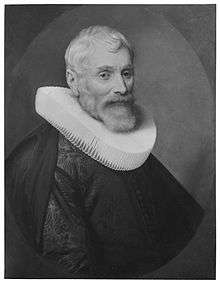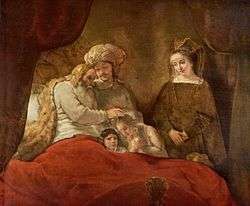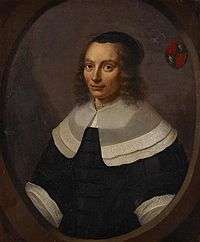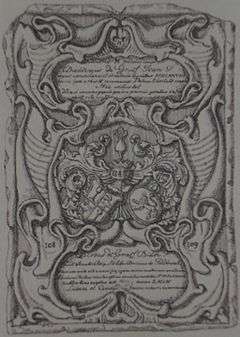Jacob Dircksz de Graeff
Jacob Dircksz de Graeff (1579/1571 – 6 October 1638) was one of the most illustrious members of the De Graeff family. He was a powerful member of the States Faction, regent and mayor of Amsterdam after the political collapse of Reinier Pauw in 1627.[1]
| Jacob Dircksz de Graeff | |
|---|---|
 | |
| Regent and Mayor of Amsterdam | |
| Reign | 1613–1638 |
| Predecessor | Reinier Pauw |
| Successor | Andries Bicker |
| Born | 1 January 1579 House De Keyser, Amsterdam |
| Died | 6 October 1638 (aged 69) |
| Burial | Oude Kerk, Amsterdam |
| Consort | Aaltje Boelens Loen |
| Issue | Cornelis de Graeff (1599–1664) Dirk de Graeff (1601–1633) Agneta de Graeff van Polsbroek (1603–1656) Wendela de Graeff Christina de Graeff (1609–1679) Andries de Graeff (1611–1678) |
| House | De Graeff |
| Father | Diederik Jansz. Graeff |
| Mother | Agnies Pietresdr van Neck |
In the mid 17th century, during the Dutch Golden Age, De Graeff controlled the city's politics in close cooperation with his nephew Andries Bicker.[2][3] Together with Bicker he was also the leader of the Arminian faction of the city.[3] Jacob de Graeff was very critical of the Orange family's influence. He was a member of a family of regents who belonged to the republican political movement also referred to as the ‘state oriented’, as opposed to the Royalists.[4]
Family de Graeff
Jacob de Graeff was born in Emden, the son of Diederik Jansz. Graeff and Agnies Pietresdr van Neck. He grew up in Emden and later in Amsterdam, in the Niezel, a small street not far from the Oude Kerk.



During the Dutch Golden Age, the De Graeff family were very critical of the Orange family’s influence in the Netherlands. Together with the Republican-minded brothers Andries, Cornelis and Jan Bicker, the De Graeffs strived for the abolition of stadtholdership. They desired the full sovereignty of the individual regions in a form in which the Republic of the United Seven Netherlands was not ruled by a single person. Instead of a sovereign (or stadtholder) the political and military power was lodged with the States General and with the regents of the cities in Holland. Jacob De Graeffs two sons Cornelis and Andries de Graeff became the strongest Dutch regents during the First Stadtholderless Period.[4][5]
As a member of the De Graeff family and regent-mayor of Amsterdam Jacob held the titles as Lord of the semisouverain fief of Zuid-Polsbroek, Lord of Sloten, Nieuwer-Amstel, Osdorp and Amstelveen. Jacob was also chieflandholder of the Zijpe- en Hazepolder, Watergraafs- and Wiemermeer.[6]
Career
De Graeff studied Classical language at Leiden University. In 1597 he married to Aaltje Boelens Loen, and among the couple's children were Cornelis, Andries and Agneta de Graeff van Polsbroek, the mother of Johan de Witt's wife Wendela Bicker. De Graeff was a merchant, and in 1598 became Schepen (alderman), from 1603 a member of the Vroedschap and in 1613–1638 mayor of Amsterdam six times.[7] He was first named as mayor of Amsterdam in 1611.[8]
During his councillorship in the States of Holland and West Friesland (1615–1617) De Graeff get sympathy with Oldenbarnevelt. In 1618, as regent-mayor of Amsterdam, Jacob de Graeff was deeply involved in the political crisis that engulfed the Oldenbarnevelt regime and brought about its fall.[7] Amsterdam was one of the Holland cities whose regents were partisans of the Remonstrants and had agitated for the Sharp Resolution of 1617 which authorized city governments to raise private armies, called waardgelders. The Counter-Remonstrants (enemies of the Remonstrants) opposed this, and the stadtholder, Maurice of Nassau viewed this policy as a challenge to his authority as commander-in-chief of the States Army. On 23 August 1618, by order of the States-General, Oldenbarnevelt and his chief supporters such as Hugo Grotius, Gilles van Ledenberg, Rombout Hogerbeets were arrested. Jacob de Graeff lost his political position in the government for some years. After the political collapse of the royalist Reinier Pauw in 1627 De Graeff returned to power again. During the late 1620s and the 1630s he controlled the city's politics in close cooperation with his nephew Andries Bicker.[7]
De Graeff died in Amsterdam and his tomb chapel can be found in the Oude Kerk floor, plots number 108 and 109. After his death his son Cornelis and the hardcore republican brothers Andries and Cornelis Bicker took over his role on the council.[4][5]
Jacob Dircksz de Graeff Born: 1569/1571 Died: 6 October 1636 | ||
| Preceded by Charles de Ligne, 2nd Prince of Arenberg |
Lord of the semisouverain Fief Zuid-Polsbroek 1610–1638 |
Succeeded by Cornelis de Graeff |
| Preceded by Gerrit Bicker and City of Amsterdam |
Lord of the manor of Sloten, Nieuwer-Amstel, Osdorp and Amstelveen 1604–1624/1638 |
Succeeded by Andries Bicker and Cornelis de Graeff |
Notes
- Biografie Andries Bicker at the dutch DBNL
- Google: De Republiek: 1477-1806, by J.I. Israel
- Google: Geschiedenis van Holland, Part 2, book 2, from Eelco Beukers
- "Triomf der Vrede (nl)". Archived from the original on 2016-10-31. Retrieved 2009-12-04.
- Pieter C. Vies Andries de Graeff (1611-1678) `t Gezagh is heerelyk: doch vol bekommeringen Archived 2012-03-01 at the Wayback Machine
- De Graeff in Historische Geslachtswapens
- P.C. Molhuysen and P.J. Blok Jacob Dircksz de Graeff at the "digitale bibliotheek voor de Nederlandse letteren" (DBNL)
- A.J. van der Aa Jacob de Graeff in: Biographisch woordenboek der Nederlanden. Deel 7
| Wikimedia Commons has media related to Jacob Dirckszoon de Graeff. |
Literature
- Elias, Johan E. (1903–1905) De vroedschap van Amsterdam, 1578-1795, p. 266
- Lademacher, Horst Phönix aus der Asche? Politik und kultur der niederländischen Republik im Europa des 17. Jahrhunderts, Münster (2007, Waxmann Verlag), p. 228
- Israel, Jonathan I. (1995) The dutch Republic - Its Rise, Greatness, and Fall - 1477-1806, Clarendon Press, Oxford, ISBN 978-0-19-820734-4
- Burke, P. (1994) Venice and Amsterdam. A study of seventeenth-century élites.